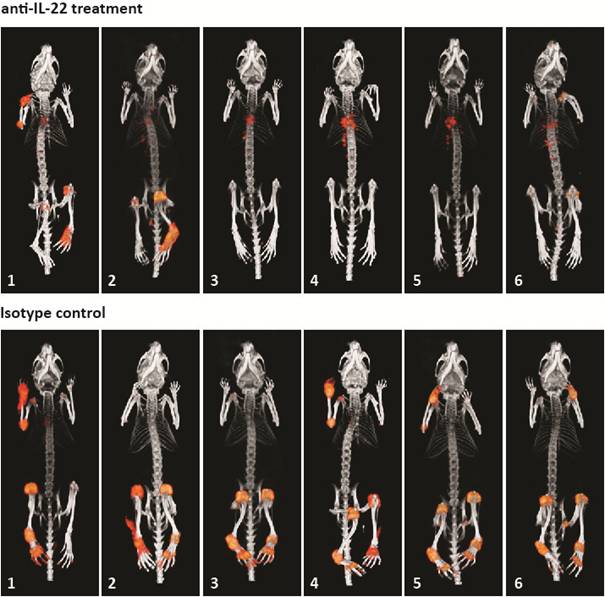Session Information
Session Type: ACR Poster Session B
Session Time: 9:00AM-11:00AM
Background/Purpose: Rheumatoid arthritis (RA) synovial tissue has been demonstrated to express high levels of fibroblast activation protein (FAP) using anti-FAP-antibody 28H1. In addition, RA patients show elevated levels of IL-22 and IL-22-producing T helper cells that correlate to erosive disease, suggesting a role for this cytokine in the pathogenesis of RA. The purpose of this study was to determine the feasibility of 111In-28H1 SPECT/CT imaging of FAP-expressing synovium to monitor the therapeutic potential of neutralizing IL-22 during experimental arthritis.
Methods: Collagen-induced arthritis (CIA) was induced in male DBA/1J mice. Mice were treated 3 times per week with anti-IL-22 antibodies (8 mg/kg), while the control group received rat IgG1 isotype control antibodies. To monitor the therapeutic effect after 2 weeks of treatment, SPECT/CT images were acquired 24 h after injection of 111In-labeled DTPA-conjugated anti-FAP antibody, 28H1. After image acquisition, mice were euthanized and dissected. Imaging results were compared with the macroscopic arthritis scores and radiographic bone damage scores acquired by X-ray.
Results: Blocking IL-22 during CIA was a potent approach to prevent arthritis development, reaching a disease incidence of only 50%, versus 100% in the control group. SPECT/CT imaging using indium-labeled anti-FAP antibodies showed that joint uptake of the tracer was significantly reduced (p = 0.03) in anti-IL-22-treated mice (4.3 %ID/g) compared to the isotype control group (8.0 %ID/g) (See figure). This was confirmed by the corresponding macroscopic arthritis scores and radiographic bone damage scores that were significantly (p = 0.047 and p = 0.017 respectively) lower in the anti-IL-22-treated group. Besides its sensitivity, the in vivo FAP-based SPECT/CT had the great advantage to visualize sites of inflammation that were overlooked during clinical scoring, like in knee, hip, elbow and shoulder (See figure).
Conclusion: These findings demonstrate that IL-22 plays an important role in the development of experimental arthritis, and targeting this cytokine seems an attractive new strategy in RA treatment. Most importantly, SPECT/CT imaging of the inflamed synovium using the labeled anti-FAP antibody 111In-DTPA-28H1 can be used to specifically monitor response to therapy in an objective and quantitative way, and is potentially more sensitive in disease monitoring compared to the standard method of clinical arthritis scoring by macroscopic inspection.
To cite this abstract in AMA style:
Roeleveld DM, van der Geest T, Walgreen B, Helsen MM, Nayak TK, Klein C, Hegen M, Laverman P, Boerman OC, Koenders MI. Sensitive SPECT/CT Imaging of Fibroblast Activation Protein Expression after Anti-IL-22 Treatment in Experimental Arthritis [abstract]. Arthritis Rheumatol. 2016; 68 (suppl 10). https://acrabstracts.org/abstract/sensitive-spectct-imaging-of-fibroblast-activation-protein-expression-after-anti-il-22-treatment-in-experimental-arthritis/. Accessed .« Back to 2016 ACR/ARHP Annual Meeting
ACR Meeting Abstracts - https://acrabstracts.org/abstract/sensitive-spectct-imaging-of-fibroblast-activation-protein-expression-after-anti-il-22-treatment-in-experimental-arthritis/

